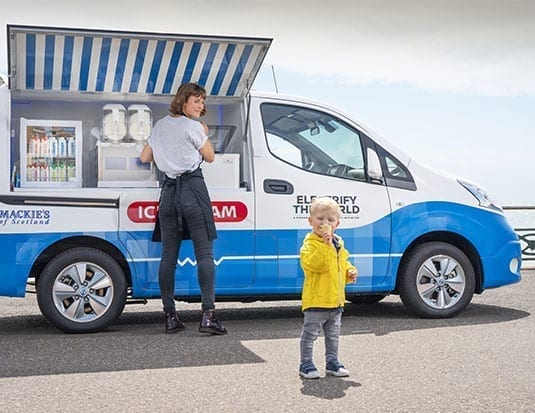Nissan develops an all-electric, zero-emission concept ice cream van for ‘Clean Air Day’ in the UK on June 20th.
Older models of most ice cream vans have diesel engines, which, when left idling to operate the refrigeration equipment, produce harmful emissions, including black carbon. Hence, Nissan partnered with Mackie’s of Scotland, an ice cream producer that powers its family-owned dairy farm by renewable wind and solar energy, to remove carbon dependence at every stage of the ice cream journey.
“We’re delighted to have worked with Nissan on this project as it’s the perfect complement to our own vision of becoming self-sustainable in renewable energy – and eliminating carbon in the journey from ‘Sky to Scoop,’” said Karin Hayhow, Marketing Director at Mackie’s of Scotland.
“At Mackie’s we’ve already shifted our dependence from fossil-fuels on to clean renewable power. We now export 4.5 times more energy to the national grid than we consume. This year we will make further progress towards our vision with the installation of an innovative new low-carbon refrigeration system. We’re proud to be a ‘climate positive’ ice cream maker.”
Clean Air Day
Clean Air Day is the UK’s biggest air pollution campaign that educates people on air pollution to help make the air cleaner and healthier for everyone.
Chris Large, Senior Partner, Global Action Plan, said “The Clean Air Day campaign is here to celebrate innovation and accelerate action. We welcome Nissan’s efforts to make ice cream vans that serve up toxic fumes a thing of the past. Schoolchildren campaigning for the Clean Van Commitment sent a video message to all van fleets encouraging them to get millions of more electric vans on to UK roads in place of diesels. I think those children would love this project.”
Nissan e-NV200 Ice Cream Van
Nissan’s 100% electric LCV (light commercial vehicle), e-NV200, helps vendors to reduce their carbon footprint with the use of a zero-emission drivetrain, second-life battery storage, and renewable solar energy generation, which is a part of Nissan’s Electric Ecosystem.
“Ice cream is enjoyed the world over, but consumers are increasingly mindful of the environmental impact of how we produce such treats and the ‘last mile’ of how they reach us,” adds Kalyana Sivagnanam, Managing Director, Nissan Motor.
“This project is a perfect demonstration of Nissan’s Intelligent Mobility strategy, applying more than a decade of EV experience and progress in battery technology to create cleaner solutions for power on the go – in ways customers might not expect. By eliminating harmful tailpipe emissions, and increasing our use of renewable energy, we can help make this a better world for everyone.”
The van has an all-electric driving range of up to 300 km in city conditions between charges (WLTP Urban City Cycle), with a 40kWh battery, and two portable power packs called Nissan Energy ROAM, that offers a clean, sustainable solution for electricity on the go and a second-life for Nissan EV batteries.
ROAM powers the onboard ice cream equipment, including the soft-serve machine, freezer drawer, and drinks fridge. The power packs also has a combined storage capacity of 1.4kWh, with both having an individual output power of 1kW, and can be recharged from a 230v mains supply (full recharge takes up to an hour) or the solar panel array on the van’s roof (full recharge takes two to four hours).
The van also has a bi-directional charging capability that can provide owners with additional revenue during winter times when it isn’t used as often. Through a V2G (Vehicle-to-Grid) charger, the van’s battery can store surplus energy from the national grid and provide it back to the grid when needed, which balances out peaks in national energy demands.
New Customer Experience
The concept van uses new approaches that are designed for a customer-facing experience, where the vendor, standing next to the van, dispenses ice cream through a hatch that opens from the side of the vehicle.
Payment can be made with cash, contactless bank card and smartphones via a tap-to-pay panel mounted on the side of the van.
The jingle has been replaced with a smart button that generates a tweet of the van’s precise location using the global addressing service What3Words. The service divides the world into 3m x 3m locations with their own three-word address. An example is ‘trendy.angel.define,’ which is a spot on Brighton & Hove’s seafront in the UK.



